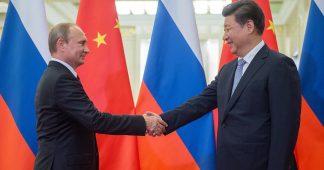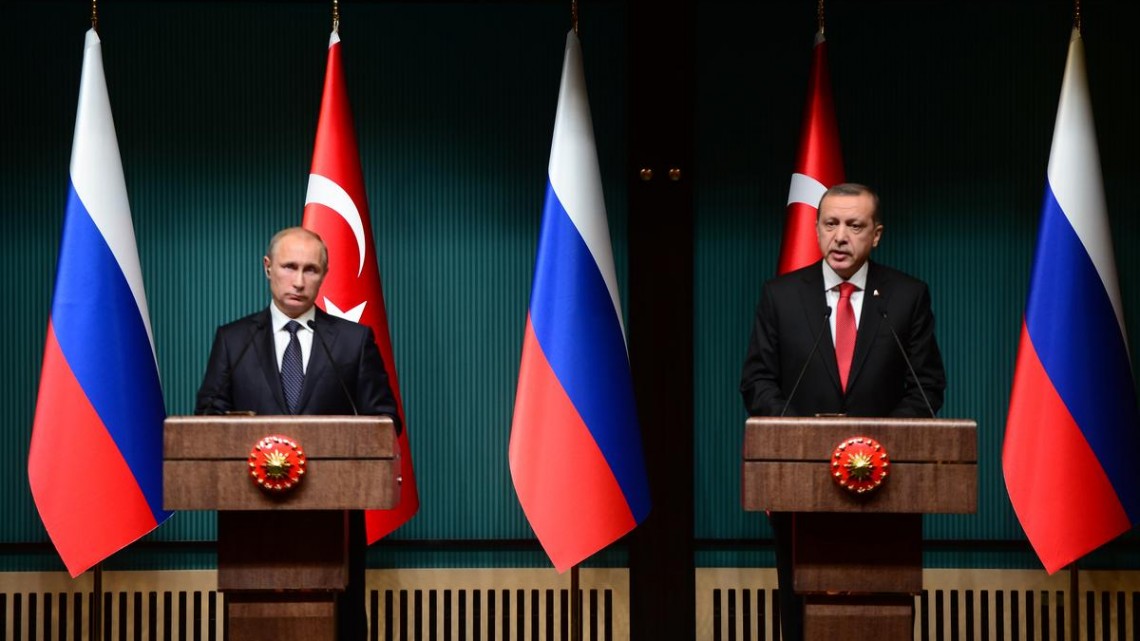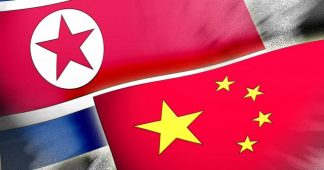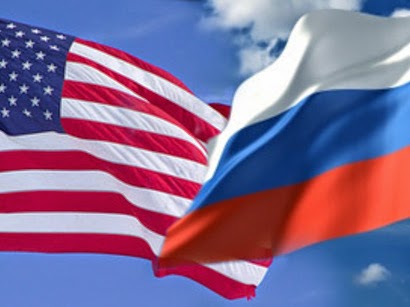From Leon Trotsky’s “History of the Russian Revolution”
The fundamental and most stable feature of Russian history is the slow tempo of her development, with the economic backwardness, primitiveness of social forms and low level of culture resulting from it.
The population of this gigantic and austere plain, open to eastern winds and Asiatic migrations, was condemned by nature itself to a long backwardness. The struggle with nomads lasted almost up to the end of the seventeenth century; the struggle with winds, bringing winter cold and summer drought, continues still. Agriculture, the basis of the whole development, advanced by extensive methods. In the north they cut down and burned up the forests, in the south they ravished the virgin steppes. The conquest of nature went wide and not deep.
While the western barbarians settled in the ruins of Roman culture, where many an old stone lay ready as building material, the Slavs in the East found no inheritance upon their desolate plain: their predecessors had been on even a lower level of culture than they. The western European peoples, soon finding their natural boundaries, created those economic and cultural clusters, the commercial cities. The population of the eastern plain, at the first sign of crowding, would go deeper into the forest or spread out over the steppe. The more aggressive and enterprising elements of the peasantry in the west became burghers, craftsmen, merchants. The more active and bold in the east became, some of them, traders, but most of them Cossacks, frontiersmen, pioneers. The process of social differentiation, intensive in the west, was delayed in the east and diluted by the process of expansion. “The Tzar of Muscovia, although a Christian, rules a lazy-minded people,” wrote Vico, a contemporary of Peter I. That “lazy” mind of the Muscovites was a reflection of the slow tempo of economic development, the formlessness of class relations, the meagerness of inner history.
The ancient civilisations of Egypt, India and China had a character self-sufficient enough, and they had time enough at their disposal, to bring their social relations, in spite of low productive powers, almost to the same detailed completion to which their craftsmen brought the products of their craft. Russia stood not only geographically, but also socially and historically, between Europe and Asia. She was marked off from the European West, but also from the Asiatic East, approaching at different periods and in different features now one, now the other. The East gave her the Tartar yoke, which entered as an important element into the structure of the Russian state. The West was a still more threatening foe – but at the same time a teacher. Russia was unable to settle in the forms of the East because she was continually having to adapt herself to military and economic pressure from the West. The existence of feudal relations in Russia, denied by former historians, may be considered unconditionally established by later investigations. Furthermore, the fundamental elements of Russian feudalism were the same as in the West. But the mere fact that the existence of the feudal epoch had to be established by means of extended scientific arguments sufficiently testifies to the incompleteness of Russian feudalism, its formlessness, its poverty of cultural monuments.
A backward country assimilates the material and intellectual conquests of the advanced countries. But this does not mean that it follows them slavishly, reproduces all the stages of their past. The theory of the repetition of historic cycles – Vico and his more recent followers – rests upon an observation of the orbits of old pre-capitalist cultures, and in part upon the first experiments of capitalist development. A certain repetition of cultural stages in ever new settlements was in fact bound up with the provincial and episodic character of that whole process. Capitalism means, however, an overcoming of those conditions. It prepares and in a certain sense realises the universality and permanence of man’s development. By this a repetition of the forms of development by different nations is ruled out. Although compelled to follow after the advanced countries, a backward country does not take things in the same order. The privilege of historic backwardness – and such a privilege exists – permits, or rather compels, the adoption of whatever is ready in advance of any specified date, skipping a whole series of intermediate stages. Savages throw away their bows and arrows for rifles all at once, without travelling the road which lay between those two weapons in the past. The European colonists in America did not begin history all over again from the beginning. The fact that Germany and the United States have now economically outstripped England was made possible by the very backwardness of their capitalist development. On the other hand, the conservative anarchy in the British coal industry – as also in the heads of MacDonald and his friends – is a paying-up for the past when England played too long the rôle of capitalist pathfinder. The development of historically backward nations leads necessarily to a peculiar combination of different stages in the historic process. Their development as a whole acquires a planless, complex, combined character.
The possibility of skipping over intermediate steps is of course by no means absolute. Its degree is determined in the long run by the economic and cultural capacities of the country. The backward nation, moreover, not infrequently debases the achievements borrowed from outside in the process of adapting them to its own more primitive culture. In this the very process of assimilation acquires a self-contradictory character. Thus the introduction of certain elements of Western technique and training, above all military and industrial, under Peter I, led to a strengthening of serfdom as the fundamental form of labour organisation. European armament and European loans – both indubitable products of a higher culture – led to a strengthening of tzarism, which delayed in its turn the development of the country.
The laws of history have nothing in common with a pedantic schematism. Unevenness, the most general law of the historic process, reveals itself most sharply and complexly in the destiny of the backward countries. Under the whip of external necessity their backward culture is compelled to make leaps. From the universal law of unevenness thus derives another law which, for the lack of a better name, we may call the law of combined development – by which we mean a drawing together of the different stages of the journey, a combining of the separate steps, an amalgam of archaic with more contemporary forms. Without this law, to be taken of course, in its whole material content, it is impossible to understand the history of Russia, and indeed of any country of the second, third or tenth cultural class.
Under pressure from richer Europe the Russian State swallowed up a far greater relative part of the people’s wealth than in the West, and thereby not only condemned the people to a twofold poverty, but also weakened the foundations of the possessing classes. Being at the same time in need of support from the latter, it forced and regimented their growth. As a result the bureaucratised privileged classes never rose to their full height, and the Russian state thus still more approached an Asiatic despotism. The Byzantine autocratism, officially adopted by the Muscovite tzars at the beginning of the sixteenth century, subdued the feudal Boyars with the help of the nobility, and then gained the subjection of the nobility by making the peasantry their slaves, and upon this foundation created the St. Petersburg imperial absolutism. The backwardness of the whole process is sufficiently indicated in the fact that serfdom, born at the end of the sixteenth century, took form in the seventeenth, flowered in the eighteenth, was juridically annulled only in 1861.
The clergy, following after the nobility, played no small rôle in the formation of the tzarist autocracy, but nevertheless a servile rôle. The church never rose in Russia to that commanding height which it attained in the Catholic West; it was satisfied with the rôle of spiritual servant of the autocracy, and counted this a recompense for its humility. The bishops and metropolitans enjoyed authority merely as deputies of the temporal power. The patriarchs were changed along with the tzars. In the Petersburg period the dependence of the church upon the state became still more servile. Two hundred thousand priests and monks were in all essentials a part of the bureaucracy, a sort of police of the gospel. In return for this the monopoly of the orthodox clergy in matters of faith, land and income was defended by a more regular kind of police.
Slavophilism, the messianism of backwardness, has based its philosophy upon the assumption that the Russian people and their church are democratic through and through, whereas official Russia is a German bureaucracy imposed upon them by Peter the Great. Mark remarked upon this theme: “In the same way the Teutonic jackasses blamed the despotism of Frederick the Second upon the French, as though backward slaves were not always in need of civilised slaves to train them.” This brief comment completely finishes off not only the old philosophy of the Slavophiles, but also the latest revelations of the “Racists.”
The meagerness not only of Russian feudalism, but of all the old Russian history, finds its most depressing expression in the absence of real mediaeval cities as centres of commerce and craft. Handicraft did not succeed in Russia in separating itself from agriculture, but preserved its character of home industry. The old Russian cities were commercial, administrative, military and manorial – centres of consumption, consequently, not of production.. Even, Novgorod, similar to Hansa and not subdued by the Tartars, was only a commercial, and not an industrial city. True, the distribution of the peasant industries over various districts created a demand for trade mediation on a large scale. But nomad traders could not possibly occupy that place in social life which belonged in the West to the craft-guild and merchant-industrial petty and middle bourgeoisie, inseparably bound up with its peasant environment. The chief roads of Russian trade, moreover, led across the border, thus from time immemorial giving the leadership to foreign commercial capital, and imparting a semi-colonial character to the whole process, in which the Russian trader was a mediator between the Western cities and the Russian villages. This kind of economic relation developed further during the epoch of Russian capitalism and found its extreme expression in the imperialist war.
The insignificance of the Russian cities, which more than anything else promoted the development of an Asiatic state, also made impossible a Reformation – that is, a replacement of the feudal-bureaucratic orthodoxy by some sort of modernised kind of Christianity adapted to the demands of a bourgeois society. The struggle against the state church did not go farther than the creation of peasant sects, the faction of the Old Believers being the most powerful among them.
Fifteen years before the great French revolution there developed in Russia a movement of the Cossacks, peasants and worker-serfs of the Urals, known as the Pugachev Rebellion. What was lacking to this menacing popular uprising in order to convert it into a revolution? A Third Estate. Without the industrial democracy of the cities a peasant war could not develop into a revolution, just as the peasant sects could not rise to the height of a Reformation. The result of the Pugachev Rebellion was just the opposite – a strengthening of bureaucratic absolutism as the guardian of the interests of the nobility, a guardian which had again justified itself in the hour of danger.
The Europeanization of the country, formally begun in the time of Peter, became during the following century more and more a demand of the ruling class itself, the nobility. In 1825 the aristocratic intelligentsia, generalising this demand politically, went to the point of a military conspiracy to limit the powers of the autocracy. Thus, under pressure from the European bourgeois development, the progressive nobility attempted to take the place of the lacking Third Estate. But nevertheless they wished to combine their liberal régime with the security of their own caste domination, and therefore feared most of all to arouse the peasantry. It s thus not surprising that the conspiracy remained a mere attempt on the part of a brilliant but isolated officer caste which gave up the sponge almost without a struggle. Such was the significance of the Dekabrist uprising.
The landlords who owned factories were the first among their caste to favour replacing serfdom by wage labour. The growing export of Russian grain gave an impulse in the same direction. In 1861 the noble bureaucracy, relying upon the liberal landlords, carried out its peasant reform. The impotent bourgeois liberalism during this operation played the rôle of humble chorus. It is needless to remark that tzarism solved the fundamental problem of Russia, the agrarian problem, in a more niggardly and thieving fashion than that in which the Prussian monarchy during the next decade was to solve the fundamental problem of Germany, its national consolidation. The solution of the problems of one class by another is one of those combined methods natural to backward countries.
The law of combined development reveals itself most indubitably, however, in the history and character of Russian industry. Arising late, Russian industry did not repeat the development of the advanced countries, but inserted itself into this development, adapting their latest achievements to its own backwardness. Just as the economic evolution of Russia as a whole skipped over the epoch of craft-guilds and manufacture, so also the separate branches of industry made a series of special leaps over technical productive stages that had been measured in the West by decades. Thanks to this, Russian industry developed at certain periods with extraordinary speed. Between the first revolution and the war, industrial production in Russia approximately doubled. this has seemed to certain Russian historians a sufficient basis for concluding that “we must abandon the legend of backwardness and slow growth.” [1] In reality the possibility of this swift growth was determined by that very backwardness which, alas, continued not only up to the moment of liquidation of the old Russia, but as her legacy up to the present day.
The basic criterion of the economic level of a nation is the productivity of labour, which in its turn depends upon the relative weight of the industries in the general economy of the country. On the eve of the war, when tzarist Russia had attained the highest point of its prosperity, the national income per capita was 8 to 10 times less than in the United States – a fact which is not surprising when you consider that 4/5 of the self-supporting population of Russia was occupied with agriculture, while in the United States, for every one engaged in agriculture, 2½ were engaged in industry. We must add that for every one hundred square kilometres of land, Russia had, on the eve of the war, 0.4 kilometres of railroads, Germany 11.7, Austria-Hungary 7. Other comparative coefficients are of the same type.
But it is just in the sphere of economy, as we have said, that the law of combined development most forcibly emerges. At the same time that peasant land-cultivation as a whole remained, right up to the revolution, at the level of the seventeenth century, Russian industry in its technique and capitalist structure stood at the level of the advanced countries, and in certain respects even outstripped them. Small enterprises, involving less than 100 workers, employed in the United States, in 1914, 35 per cent of the total of industrial workers, but in Russia 17.8 per cent. The two countries had an approximately identical relative quantity of enterprises involving 100 to 1000 workers. But the giant enterprises, above 1000 workers each, employed in the United States 17.8 per cent of the workers and in Russia 41.4 per cent! For the most important industrial districts the latter percentage is still higher: for the Petrograd district 44.4 per cent, for the Moscow district even 57.3 per cent. We get a like result if we compared Russian with British or German industry. This fact – first established by the author in 1908 – hardly accords with the banal idea of the economic backwardness of Russia. However, it does not disprove this backwardness, but dialectically completes it.
The confluence of industrial with bank capital was also accomplished in Russia with a completeness you might not find in any other country. But the subjection of the industries to the banks meant, for the same reasons, their subjection to the western European money market. Heavy industry (metal, coal, oil) was almost wholly under the control of foreign finance capital, which had created for itself an auxiliary and intermediate system of banks in Russia. Light industry was following the same road. Foreigners owned in general about 40 per cent of all the stock capital of Russia, but in the leading branches of industry that percentage was still higher. We can say without exaggeration that the controlling shares of stock in the Russian banks, plants and factories were to be found abroad, the amount held in England, France and Belgium being almost double that in Germany.
The social character of the Russian bourgeoisie and its political physiognomy were determined by the condition of origin and the structure of Russian industry. The extreme concentration of this industry alone meant that between the capitalist leaders and the popular masses there was no hierarchy of transitional layers. To this we must add that the proprietors of the principal industrial, banking, and transport enterprises were foreigners, who realised on their investment not only the profits drawn from Russia, but only a political influence in foreign parliaments, and so not only did not forward the struggle for Russian parliamentarism, but often opposed it: it is sufficient to recall the shameful rôle played by official France. such are the elementary and irremovable causes of the political isolation and anti-popular character of the Russian bourgeoisie. Whereas in the dawn of its history it was too unripe to accomplish a Reformation; when the time came for leading a revolution it was overripe.
In correspondence with this general course of development of the country, the reservoir from which the Russian working class formed itself was not the craft-guild, but agriculture, not the city, but the country. Moreover, in Russia the proletariat did not arise gradually through the ages, carrying with itself the burden of the past as in England, but in leaps involving sharp changes of environment, ties, relations, and a sharp break with the past. It is just this fact – combined with the concentrated oppressions of tzarism – that made the Russian workers hospitable to the boldest conclusions of revolutionary thought – just as the backward industries were hospitable to the last word in capitalist organisation.
The Russian proletariat was forever repeating the short history of its origin. While in the metal industry, especially in Petrograd, a layer of hereditary proletarians was crystallised out, having made a complete break with the country, in the Urals the prevailing type was half-proletarian, half-peasant. A yearly inflow of fresh labour forces from the country in all the industrial districts kept renewing the bonds of the proletariat with its fundamental social reservoir.
The incapacity of the bourgeoisie for political action was immediately caused by its relation to the proletariat and the peasantry. It could not lead after it workers who stood hostile in their everyday life, and had so early learned to generalise their problems. But it was likewise incapable of leading after it the peasantry, because it was entangled in a web of interests with the landlords, and dreaded a shake-up of property relations in any form. The belatedness of the Russian revolution was thus not only a matter of chronology, but also of the social structure of the nation.
England achieved her Puritan revolution when her whole population was not more than 5½ millions, of whom half a million were to be found in London. France, in the epoch of her revolution, had in Paris also only half a million out of a population of 25 million, Russia at the beginning of the twentieth century had a population of about 150 million, of whom more than 3 million were in Petrograd and Moscow. Behind these comparative figures lurk enormous social differences. Not only England of the seventeenth century, but also France of the eighteenth had no proletariat in the modern sense. In Russia, however, the working class in all branches of labour, both city and village, numbered in 1905 no less than 10 million, which with their families amounts to more than 25 million – that is to say, more than the whole population of France in the epoch of the great revolution. Advancing from the sturdy artisans and independent peasants of the army of Cromwell – through the sansculottes of Paris – to the industrial proletarians of St. Petersburg, the revolution had deeply changed its social mechanism, its methods, and therewith its aims.
The events of 1905 were a prologue to the two revolutions of 1917, that of February and that of October. In the prologue all the elements of the drama were included, but not carried through. The Russo-Japanese war had made tzarism totter. Against the background of a mass movement the liberal bourgeoisie had frightened the monarchy with its opposition. The workers had organised independently of the bourgeoisie, and in opposition to it, in soviets, a form of organisation then first called into being. Peasant uprisings to seize the land occurred throughout vast stretches of the country. Not only the peasants, but also the revolutionary parts of the army tended toward the soviets, which at the moment of highest tension openly disputed the power with the monarchy. However, all the revolutionary forces were then going into action for the first time, lacking experience and confidence. The liberals demonstratively backed away from the revolution exactly at the moment when it became clear that to shake tzarism would not be enough, it must be overthrown. This sharp break of the bourgeoisie with the people, in which the bourgeoisie carried with it considerable circles of the democratic intelligentsia, made it easier for the monarchy to differentiate within the army, separating out the loyal units, and to make a bloody settlement with the workers and peasants. Although with a few broken ribs, tzarism came out of the experience of 1905 alive and strong enough.
What changes in the correlation of forces were introduced by the eleven years’ historical development dividing the prologue from the drama? Tzarism during this period came into still sharper conflict with the demands of historic development. The bourgeoisie became economically more powerful, but as we have seen its power rested on a higher concentration of industry and an increased predominance of foreign capital. Impressed by the lessons of 1905, the bourgeoisie had become more conservative and suspicious. The relative weight of the petty and middle bourgeoisie, insignificant before, had fallen still lower. The democratic intelligentsia generally speaking had no firm social support whatever. It could have a transitional political influence, but could play no independent rôle: its dependence upon bourgeois liberalism had grown enormously. In these circumstances only the youthful proletariat could give the peasantry a programme, a banner and leadership. The gigantic tasks thus presented to the proletariat gave rise to a urgent necessity for a special revolutionary organisation capable of quickly getting hold of the popular masses and making them ready for revolutionary action under the leadership of the workers. Thus the soviets of 1905 developed gigantically in 1917. That the soviets, we may remark here, are not a mere child of the historical backwardness of Russia, but a product of her combined development, is indicated by the fact that the proletariat of the most industrial country, Germany, at the time of its revolutionary high point – 1918 to 1919 – could find no other form of organisation.
The revolution of 1917 still had as its immediate task the overthrow of the bureaucratic monarchy, but in distinction from the older bourgeois revolutions, the decisive force now was a new class formed on the basis of a concentrated industry, and armed with new organisations, new methods of struggle. The law of combined development here emerges in its extreme expression: starting with the overthrow of a decayed mediaeval structure, the revolution in the course of a few months placed the proletariat and the Communist Party in power.
In its initial task the Russian revolution was thus a democratic revolution. But it posed the problem of political democracy in a new way. While the workers were covering the whole country with soviets, including in them the soldiers and part of the peasantry, the bourgeoisie still continued to dicker – shall we summon or not summon a Constituent Assembly? In the course of our exposition this question will rise before us in full completeness. Here we wish only to mark the place of the soviets in the historic succession of revolutionary ideas and forms.
In the middle of the seventeenth century the bourgeois revolution in England developed under the guise of a religious reformation. A struggle for the right to pray according to one’s own prayer book was identified with the struggle against the king, the aristocracy, the princes of the church, and Rome. The Presbyterians and Puritans were deeply convinced that they were placing their earthly interests under the unshakeable protection of the divine Providence. The goals for which the new classes were struggling commingled inseparably in their consciousness with texts from the Bible and the forms of churchly ritual. Emigrants carried with them across the ocean this tradition sealed with blood. Hence the extraordinary virility of the Anglo-Saxon interpretation of Christianity. We see even today how the minister “socialists” of Great Britain back up their cowardice with these same magic texts with which the people of the seventeenth century sought to justify their courage.
In France, which stepped across the Reformation, the Catholic Church survived as a state institution until the revolution, which found its expression and justification for the tasks of the bourgeois society, not in texts from the Bible, but in the abstractions of democracy. Whatever the hatred of the present rulers of France for Jacobinism, the fact is that only thanks to the austere labour of Robespierre are they still able to cover their conservative rulership with those formulas with the help of which the old society was exploded.
Each of the great revolutions marked off a new stage of the bourgeois society, and new forms of consciousness for its classes. Just as France stepped over the Reformation, so Russia stepped over the formal democracy. The Russian revolutionary party, which was to place its stamp upon a whole epoch, sought an expression for the tasks of the revolution neither in the Bible nor in that secularised Christianity called “pure” democracy, but in the material relations of the social classes. The soviet system gave to those relations their simplest, most undisguised and transparent expression. The rule of the toilers has for the first time been realised in the soviet system, which, whatever its immediate historic vicissitudes, has penetrated as irrevocably into the consciousness of the masses as did in its day the system of the Reformation or of pure democracy.











